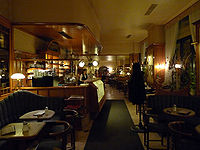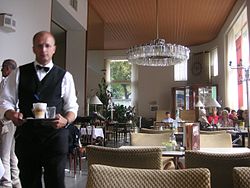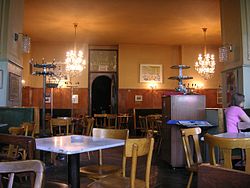- Viennese Coffee House
-
The Viennese Coffee House (German: Wiener Kaffeehaus) is a typical institution of Vienna that played an important part shaping Viennese culture.
Since October 2011 the "Viennese Coffee House Culture" is listed as "Intangible Cultural Heritage" in the "Austrian Inventory" of the "National Agency for the Intangible Cultural Heritage", a part of UNESCO. The Viennese Coffee House is described in this inventory as a place “where time and space are consumed, but only the coffee is found on the bill.”[1]
Contents
The Viennese Coffehouse Culture
 Café Central in Vienna
Café Central in Vienna
Unlike some other café traditions around the world, it is completely normal for a customer to linger alone for hours and study the omnipresent newspaper. Along with coffee, the waiter will serve an obligatory glass of cold tap water and during a long stay will often bring additional water unrequested, with the idea being that you are a guest who should feel welcomed and not pressured to leave for another patron.
In the late 19th and early 20th century, leading writers of the time became attached to the atmosphere of Viennese cafés and were frequently seen to meet, exchange and to even write there. Literature composed in cafés is commonly referred to as coffee house literature, the writers thereof as coffee house poets. The famous journal Die Fackel ("The Torch") by Karl Kraus is said to have been written in cafés to a large extent. Other coffee house poets include Arthur Schnitzler, Alfred Polgar, Friedrich Torberg, and Egon Erwin Kisch. Famous writer and poet Peter Altenberg even had his mail delivered to his favorite café, the Café Central.
The furnishings of a Viennese café can vary from plush and comfy to coldly modern and stylish. The classic look includes Michael Thonet chairs and marble tabletops.
Many cafés provide small food dishes like sausages as well as desserts, cakes and tarts, like Apfelstrudel, Millirahmstrudel (milk-cream strudel) and Linzer torte.
In many classic cafés (for example Café Diglas, Café Central, Café Prückel) piano music is played in the evening and social events like literary readings are held. In warmer months, customers can often sit outside in a Schanigarten.
History
Legend has it that soldiers of the Polish-Habsburg army, while liberating Vienna from the second Turkish siege in 1683, found a number of sacks with strange beans that they initially thought were camel feed and wanted to burn. The Polish king Jan III Sobieski granted the sacks to one of his officers named Jerzy Franciszek Kulczycki, who started the first coffee house. After some experimentation, he added some sugar and milk, and the Viennese coffee tradition was born. This achievement has been recognized in many modern Viennese coffeehouses by hanging a picture of Kulczycki in the window.[2] Another account is that Kulczycki, having spent two years in Ottoman captivity, knew perfectly well what coffee really is and tricked his superiors into granting him the beans that were considered worthless.[3]
Vienna's first coffee house was opened by the Greek Johannes Theodat in 1685. 15 years later, four Greek owned coffeehouses had the privilege to serve coffee.[4]
The new drink was well received, and coffee houses began to pop up rapidly. In the early period, the various drinks had no names, and customers would select the mixtures from a colour-shaded chart.
The heyday of the coffee house was the turn of the nineteenth century when writers like Peter Altenberg, Alfred Polgar, Karl Kraus, Hermann Broch and Friedrich Torberg made them their preferred place of work and pleasure. Many famous artists, scientists, and politicians of the period such as Arthur Schnitzler, Stefan Zweig, Egon Schiele, Gustav Klimt, Adolf Loos, Theodor Herzl, Alfred Adler,[5] and even Leon Trotsky were constant coffee house patrons. In Prague, Budapest, Cracow, and Lviv (Lemberg) and other cities of the Austro-Hungarian empire there were also many coffee houses according to the Viennese model.
From 1950, the period of "coffee house death" or Kaffeehaussterben began, as many famous Viennese coffee houses had to close, in parts due to the popularity of television and the appearance of modern espresso bars, but mostly as a result of the Holocaust devastating a large part of what made the Vienese coffee house a cultural institution. Nevertheless, many of these classic Viennese spots still exist, and tourism and a renewed interest in their history have prompted a comeback.
Well-known coffee houses
The Café Westend in Neubau
- Kaffee Alt Wien, Bäckerstraße 9
- Café Bräunerhof, Stallburggasse 2 - Thomas Bernhard's favourite café in Vienna
- Café Central, in the Palais Ferstel, entrance of Herrengasse 14 (corner of Strauchgasse) — Peter Altenberg's favorite café and at times his primary address
- Café Demel, Kohlmarkt 14 - the most famous sweet bakery, less of a typical café
- Café Diglas, Wollzeile 10
- Café Frauenhuber, Himmelpfortgasse 6 - Vienna's oldest café.
- Café Griensteidl, Michaelerplatz 2 — newly opened at the site of the classic Café Griensteidl (1847–1897) in 1990
- Café Hawelka, Dorotheergasse 6
- Café Hummel, Josefstädterstraße 66
- Café Imperial, Kartner Ring 16- Inside the Imperial Hotel.
- Kleines Café, Franziskanerplatz 3. Considered the smallest café in town. Known from the movie Before Sunrise.
- Café Korb, Brandstätte 9
- Café Landtmann, Dr.-Karl-Lueger-Ring 4 - Sigmund Freud's preferred café.
- Café Mozart, Albertinaplatz 2 (opposite the Albertina)
- Café Museum, Operngasse 7
- Café Prückel, Stubenring 24 (at the corner of Dr. Karl-Lueger-Platz)
- Café Raimund, Museumstraße 6
- Hotel Sacher, Philharmonikerstraße 4 (a café part of the Hotel Sacher)
- Café Schottenring, Schottenring 19
- Café Schwarzenberg, Kärntner Ring 17 (at Schwarzenbergplatz)
- Café Sperl, Gumpendorferstraße 11, Adolf Hitler's preferred café[citation needed].
- Café Tirolerhof, Führichgasse 8
- Weinwurm/Café Weinwurm, or M. Weinwurm & Sohn KG, Stephansplatz, founded by Maria Weinwurm
- Aida, a well-known chain located all over the city. Fairly inexpensive compared to the other options. A popular location is right beside Stephansplatz.
Former coffee houses
- Café Scheidl zum Fenstergucker (also known as Josef Scheidl's Café or Café Fenstergucker), Kärntnerstraße or Walfischgasse 1, founded by Josef Scheidl in 1886 [6], now "Starbucks Coffee"
- Café Herrenhof in Herrengasse 10 in the first district. It was founded in 1918 and was for a period the most important meeting place for Viennese writers. The café closed in 1962.
References
- ^ Intangible Cultural Heritage in Austria: Viennese Coffee House Culture
- ^ Cooperative Coffees, Coffee Timeline
- ^ Krystyna Bockenheim, Przy polskim stole, Wroclaw 2003, p. 69
- ^ Teply, Karl: Die Einführung des Kaffees in Wien. Verein für Geschichte der Stadt Wien, Wien 1980, Vol. 6. p. 104. citated in: Seibel, Anna Maria: Die Bedeutung der Griechen für das wirtschaftliche und kulturelle Leben in Wien. p. 94 online available under: http://othes.univie.ac.at/2016/ (.pdf)
- ^ Hoffman, E. (1994). The Drive for Self: Alfred Adler and the founding of Individual Psychology. Reading, MA: Addison Wesley, pp. 52, 77, 85-86, 101
- ^ Starbucks, Cafe Fenstergucker (German)
- Bibliography
- Wurmdobler, Christopher (2005). Kaffeehäuser in Wien. Ein Führer durch eine Wiener Institution. Klassiker, moderne Cafés, Konditoreien, Coffeeshops. Falter Verlag. ISBN 3854393326.
- Béatrice Gonzalés-Vangell, Kaddish Et Renaissance - La Shoah Dans Les Romans Viennois (1991–2001) De Robert Schindel, Robert Menasse Et Doron Rabinovici , Presses Universitaires Du Septentrion, 2005, 328 pages. ISBN 2-85939-900-3
Coffee Topics - Economics
- Fair trade
- Health effects
- History
Production by
countrySpecies and
varietiesMajor
componentsProcessing Preparation Popular
beverages- Affogato
- Americano
- Bicerin
- Cà phê sữa đá
- Café au lait
- Café con leche
- Café Cubano
- Cafe mocha
- Caffè corretto
- Caffè macchiato
- Cappuccino
- Carajillo
- Coffee milk
- Cortado
- Espresso
- Flat white
- Frappuccino
- Galão
- Greek frappé coffee
- Iced coffee
- Indian filter coffee
- Ipoh white coffee
- Irish coffee
- Kopi Luwak
- Latte
- Latte macchiato
- Liqueur coffee
- Long black
- Red eye
- Ristretto
- Turkish coffee
Substitutes Lifestyle Café · Cafe church · Café Philosophique · Cannabis coffee shop · Cat cafe · Cosplay restaurant (Maid cafe) · Internet café · Konditorei · Kopi tiam · Mamak stall · Manga cafe · Manhwabang · Meikyoku kissa · No-pan kissa · Parisian café · Penny University · Sidewalk cafe · Utagoe coffeehouse · Viennese caféCategories:- Cafés in Vienna
- Coffee culture in Vienna
- Vienna culture
- Types of coffeehouses
Wikimedia Foundation. 2010.








